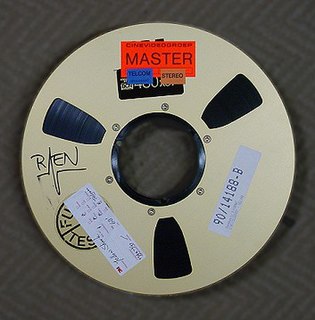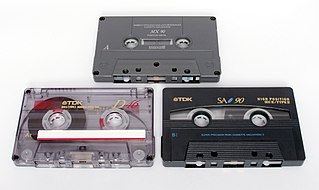Related Research Articles

Magnetic tape is a medium for magnetic recording, made of a thin, magnetizable coating on a long, narrow strip of plastic film. It was developed in Germany in 1928, based on magnetic wire recording. Devices that record and playback audio and video using magnetic tape are tape recorders and video tape recorders respectively. A device that stores computer data on magnetic tape is known as a tape drive.

An audio tape recorder, also known as a tape deck, tape player or tape machine or simply a tape recorder, is a sound recording and reproduction device that records and plays back sounds usually using magnetic tape for storage. In its present-day form, it records a fluctuating signal by moving the tape across a tape head that polarizes the magnetic domains in the tape in proportion to the audio signal. Tape-recording devices include the reel-to-reel tape deck and the cassette deck, which uses a cassette for storage.

Ampex is an American electronics company founded in 1944 by Alexander M. Poniatoff as a spin-off of Dalmo-Victor. The name AMPEX is a portmanteau, created by its founder, which stands for Alexander M. Poniatoff Excellence. Today, Ampex operates as Ampex Data Systems Corporation, a subsidiary of Delta Information Systems, and consists of two business units. The Silicon Valley unit, known internally as Ampex Data Systems (ADS), manufactures digital data storage systems capable of functioning in harsh environments. The Colorado Springs, Colorado unit, referred to as Ampex Intelligent Systems (AIS), serves as a laboratory and hub for the company's line of industrial control systems, cyber security products and services and its artificial intelligence/machine learning technology.

Reel-to-reel audio tape recording, also called open-reel recording, is magnetic tape audio recording in which the recording tape is spooled on a reel. To prepare for use, the supply reel containing the tape is placed on a spindle or hub. The end of the tape is manually pulled from the reel, threaded through mechanical guides and over a tape head assembly, and attached by friction to the hub of the second, initially empty takeup reel. Reel-to-reel systems use tape that is 1⁄4, 1⁄2, 1, or 2 inches wide, which normally moves at 3+3⁄4, 7+1⁄2, 15 or 30 inches per second. All standard tape speeds are derived as a binary submultiple of 30 inches per second.
The Digital Audio Stationary Head or DASH standard is a reel-to-reel, digital audio tape format introduced by Sony in early 1982 for high-quality multitrack studio recording and mastering, as an alternative to analog recording methods. DASH is capable of recording two channels of audio on a quarter-inch tape, and 24 or 48 tracks on 1⁄2-inch-wide (13 mm) tape on open reels of up to 14 inches. The data is recorded on the tape linearly, with a stationary recording head, as opposed to the DAT format, where data is recorded helically with a rotating head, in the same manner as a VCR. The audio data is encoded as linear PCM and boasts strong cyclic redundancy check (CRC) error correction, allowing the tape to be physically edited with a razor blade as analog tape would, e.g. by cutting and splicing, and played back with no loss of signal. In a two-track DASH recorder, the digital data is recorded onto the tape across nine data tracks: eight for the digital audio data and one for the CRC data; there is also provision for two linear analog cue tracks and one additional linear analog track dedicated to recording time code.

1–inch type B VTR is a reel-to-reel analog recording video tape format developed by the Bosch Fernseh division of Bosch in Germany in 1976. The magnetic tape format became the broadcasting standard in continental Europe, but adoption was limited in the United States and United Kingdom, where the Type C videotape VTR met with greater success.

Sound recording and reproduction is an electrical, mechanical, electronic, or digital inscription and re-creation of sound waves, such as spoken voice, singing, instrumental music, or sound effects. The two main classes of sound recording technology are analog recording and digital recording.

Magnetophone, or simply Magnetophon, was the brand or model name of the pioneering reel-to-reel tape recorder developed by engineers of the German electronics company AEG in the 1930s, based on the magnetic tape invention by Fritz Pfleumer. AEG created the world's first practical tape recorder, the K1, first demonstrated in Germany in 1935 at the Berlin Radio Show.
Foster Denki KK is an electronics company that manufactures loudspeakers and audio equipment for other companies or sells them under the trade name Fostex. It is traded on the Tokyo Stock Exchange.

Preservation of magnetic audiotape comprises techniques for handling, cleaning and storage of magnetic audiotapes in an archival repository. Multiple types of magnetic media exist but are mainly in the form of open reels or enclosed cassettes. Although digitization of materials on fragile magnetic media in library and information science is a common practice, there remains a need for conserving the actual physical magnetic tape and playback equipment as artifacts.

The RCA tape cartridge is a magnetic tape audio format that was designed to offer stereo quarter-inch reel-to-reel tape recording quality in a convenient format for the consumer market. It was introduced in 1958, following four years of development. This timing coincided with the launch of the stereophonic phonograph record. It was introduced to the market by RCA in 1958.

A dictation machine is a sound recording device most commonly used to record speech for playback or to be typed into print. It includes digital voice recorders and tape recorder.
Tape or Tapes may refer to:

Denka Company Limited; formerly Denki Kagaku Kogyo Kabushiki Kaisha (電気化学工業株式会社) is a Japanese chemical company, established in 1915 and headquartered in Tokyo, manufacturing organic and inorganic chemicals, cement, special cement additives, electronic component transfer materials and food packaging materials. The company is listed on the Tokyo Stock Exchange and is a constituent of the Nikkei 225 stock index.
A sound follower, also referred to as separate magnetic, sepmag, magnetic film recorder, or mag dubber, is a device for the recording and playback of film sound that is recorded on magnetic film. This device is locked or synchronized with the motion picture film containing the picture. It operates like an analog reel-to-reel audio tape recording, but using film, not magnetic tape. The unit can be switched from manual control to sync control, where it will follow the film with picture.

Gábor Kornél Tolnai, born November 22, 1902 in Budapest, died on February 3, 1982 in Stockholm, was a Hungarian-Swedish Diploma engineer, inventor, constructor, mechanical engineer, precision engineer, electrical engineer and a self-employed person. He is best known for his inventions and patents for spinning machines, devices for the Swedish National Defense and several types of tape recorders.
Matthew "Mat" Taylor, better known by his channel's name Techmoan, is a YouTuber and blogger active since May 2009, featuring consumer tech reviews and "RetroTech" documentaries about technology of historical interest.

Electric music technology refers to musical instruments and recording devices that use electrical circuits, which are often combined with mechanical technologies. Examples of electric musical instruments include the electro-mechanical electric piano, the electric guitar, the electro-mechanical Hammond organ and the electric bass. All of these electric instruments do not produce a sound that is audible by the performer or audience in a performance setting unless they are connected to instrument amplifiers and loudspeaker cabinets, which made them sound loud enough for performers and the audience to hear. Amplifiers and loudspeakers are separate from the instrument in the case of the electric guitar, electric bass and some electric organs and most electric pianos. Some electric organs and electric pianos include the amplifier and speaker cabinet within the main housing for the instrument.
Bernard August Cousino was a music technology inventor. He is known for inventing an endless loop tape cartridge design in 1952, known as the Audio Vendor, patented under US2804401A. The tape is pulled from the inside of a loose tape roll making it spin to wind the returning tape onto the roll again. Initially, this mechanism was mounted on a reel to reel tape recorder. Later Cousino developed a plastic housing to be hung up on some tape recorders. First, the magnetic coating was wound to the inside of the reel. This cartridge was marketed by John Herbert Orr as the Orrtronic Tapette. Newer cartridges had magnetic coating wind of the tape outside the reel, which required a special recorder to operate it, but offers comfortable simple inserting the cartridge without threading the tape. This more compact cartridges do not require any bottom spare for the tape head assembly. That would inspire George Eash to make the Fidelipac tape cartridge, which itself would inspire the Stereo-Pak tape cartridge.

The Sanyo Micro Pack 35 was a portable magnetic audio tape recording device, developed by Sanyo in 1964, that employed a special tape cartridge format with tape reels atop each other.
References
- 1 2 For teachers – pictures that talk, Popular Science, Ausgabe Mai 1973, S. 94
- ↑ US 3074724,Sakae Fujimoto, Nihon Denki Bunka Kogyo Kabush, Riken Kogaku Kogyo Kabushiki K,"Apparatus for positioning recording and recorded sheets on a magnetic recorder and reproducer",published 1960-09-14
- ↑ US 3046357,Sakae Fujimoto, Nihon Denki Bunka Kogyo Kabush, Riken Kogaku Kogyo Kabushiki K,"Magnetic recording and reproducing machine",published 1960-09-07
- ↑ Techmoan: RetroTech: Recordable Paper - The 3M Sound Page, YouTube, 12 April 2018
- ↑ Synchrofax R.P at the Radio Museum, retrieved 22 April 2018